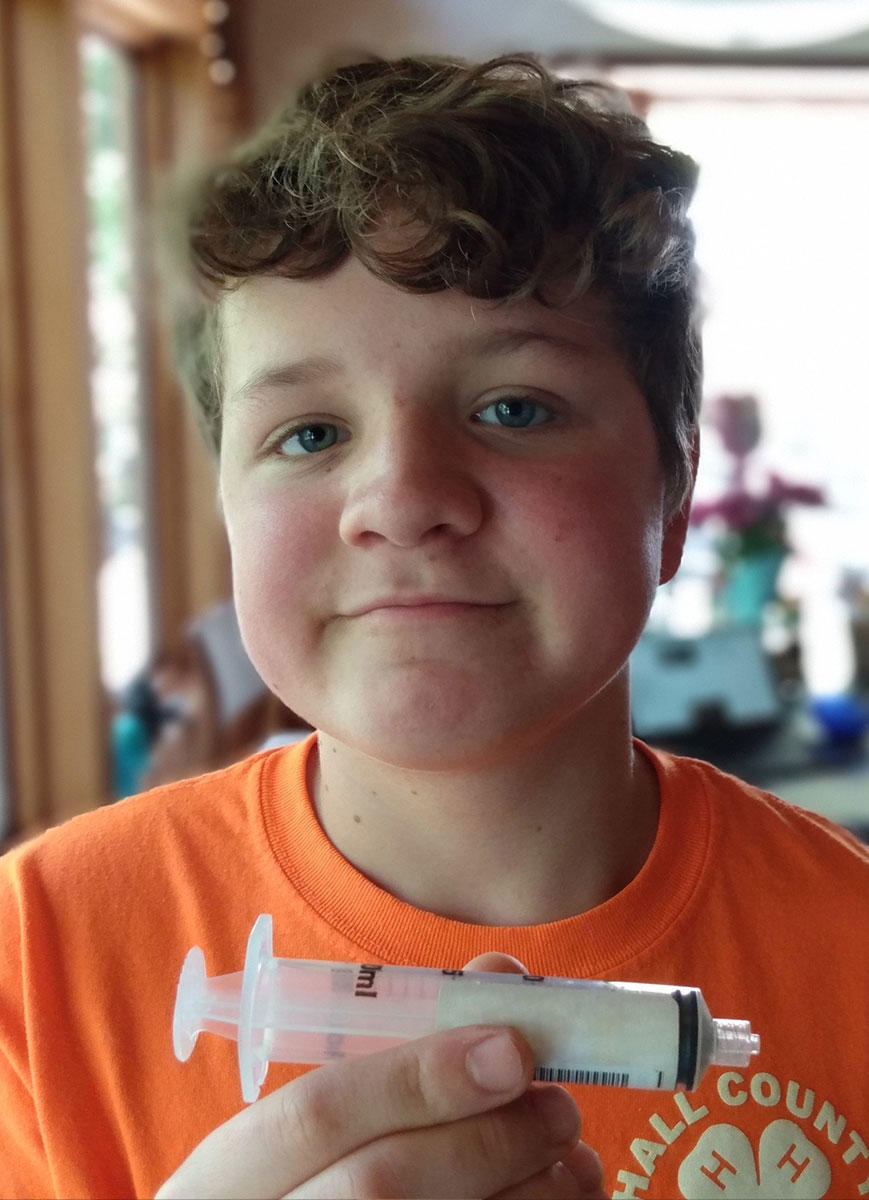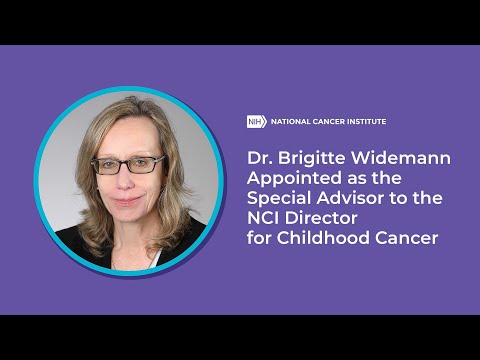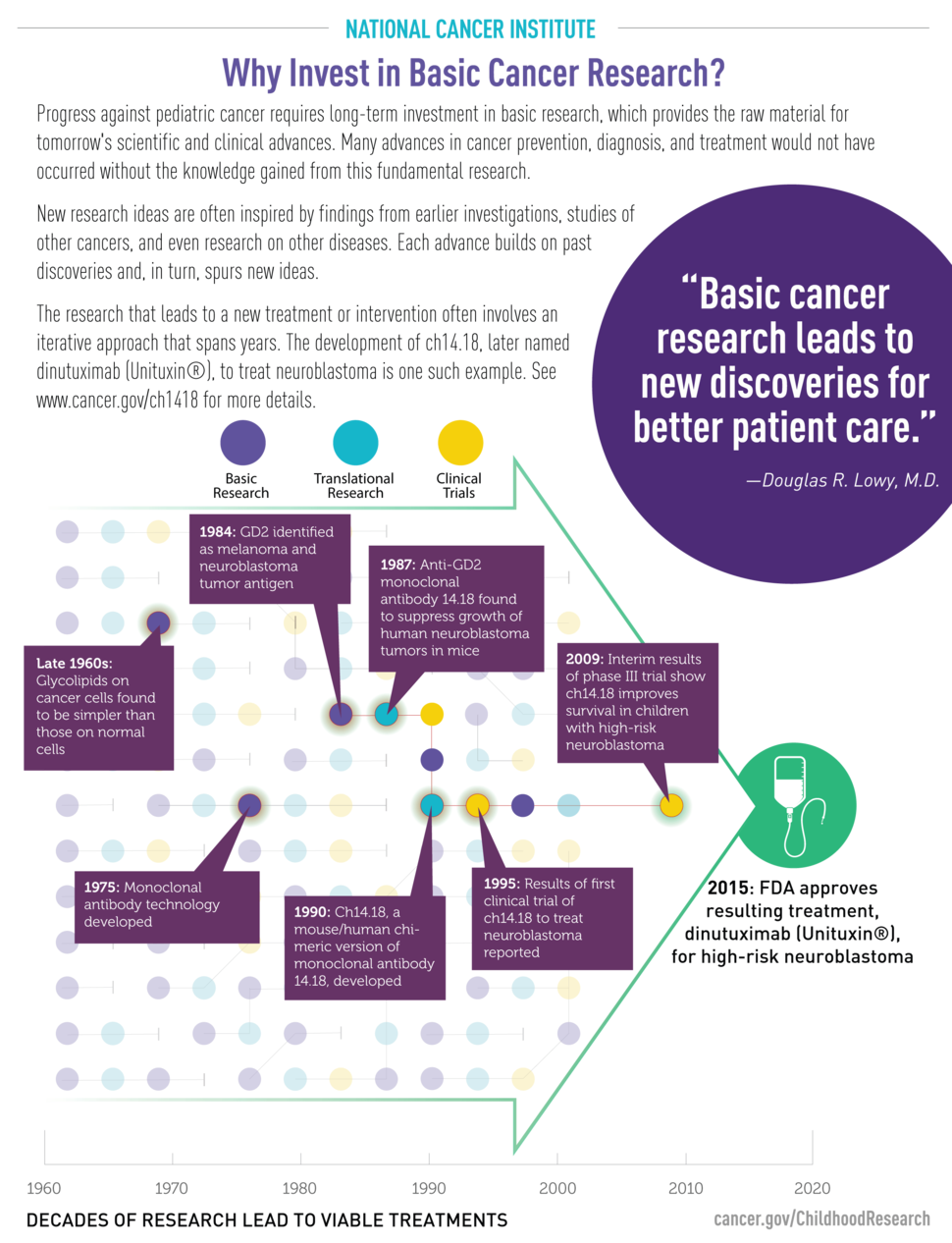Why Research is Critical to Progress against Childhood Cancer
Cancer is the leading cause of death from disease among children in the United States. Although substantial progress has been made in the treatment of several types of childhood cancer over the past five decades, progress against other types has been limited. Even when long-term survival is achieved, many survivors of childhood cancer may experience long-term adverse effects from the disease or its treatment.
Clearly, more research is needed to develop new, more-effective, and safer treatments for childhood cancer. And infrastructure and practices that allow researchers to learn from every child with cancer need to be put in place.
NCI has a number of programs that address childhood cancers specifically, and many of the institute’s other research programs are applicable to children with cancer even if they aren’t focused specifically on pediatric cancers. The institute supports a broad range of biomedical research that is relevant to this population, including:
- Basic research to enhance our understanding of the fundamental mechanisms of cancer
- Clinical research to test new treatments for safety and effectiveness
- Survivorship research to reduce the long-term adverse effects of cancer and its treatment
Challenges in Childhood Cancer Research
One challenge in conducting research on childhood cancer is that cancers in children and adolescents are relatively uncommon. Childhood cancers represent less than 1% of all new cases of cancer diagnosed in the United States each year. Because the number of children with cancer is small and patients are treated at many different institutions, answering complex biological questions about childhood cancer requires collaboration.
As clinical trials are increasingly restricted to smaller numbers of patients who are defined by the molecular characteristics of their tumors rather than where the tumors originated in the body, collaboration among children’s cancer centers and a strong national clinical research program are essential to ensure that trials enroll sufficient numbers of participants to produce meaningful results.
In addition, more efficient ways to curate and share research knowledge—from genomic data to clinical outcomes—need to be developed to speed progress against childhood cancers.
Another challenge is that, although most cancers in children (and adults) are thought to develop as a result of genetic changes that lead to uncontrolled cell growth and eventually cancer, the causes of most of these genetic changes in children are unknown. A small percentage of cancers in children can be linked to inherited genetic changes or to exposure to diagnostic or therapeutic radiation. But environmental causes have not been identified for most childhood cancers. As a result, identifying opportunities to prevent childhood cancer may be difficult.
In addition, the types of cancers children develop, and the biology of those cancers, generally differ from those of cancers diagnosed in adults. For example, tumors that originate in developing organs and tissues (such as retinoblastomas in the eye and osteosarcomas in bone) are more common in children.
Moreover, most childhood cancers have relatively few genetic alterations, and they often lack the genetic targets for treatments that have been developed and approved for cancers occurring in adults. And drugs that target signaling pathways that are active in some adult cancers might be difficult to use in children, given that many of these signaling pathways are essential for normal development.
In fact, the genetic changes that drive childhood cancers are often distinct from those in adult cancers. For example, chromosomal translocations that fuse parts of different genes together to form fusion oncoproteins are common in childhood cancer. Although fusion oncoproteins are also found in some adult cancers, those found in children have proven particularly difficult to target. Another contributing factor to the small number of targeted therapies for childhood cancers is that the rarity of these diseases has been an impediment to commercial drug development.
Developing new treatments that are less toxic and cause fewer adverse effects (both acute and late) than current treatments and developing interventions to mitigate the adverse effects of both current and future treatments are additional challenges in childhood cancer research. The late effects of some childhood cancer therapies can have profound physical, emotional, and other consequences for survivors, including a shortened life expectancy. Finding ways to minimize and address these late effects to improve both the quality and the length of life of survivors is a research priority.
More information about cancer drug metabolism in children, which varies with developmental age, is also needed, as are better laboratory and animal models for screening and testing drugs for potential use in children and adolescents. The optimal use of radiation therapy in treating childhood cancers also needs to be defined so that efficacy is maintained or increased while long-term side effects are reduced.
Basic Research Drives Progress against Childhood Cancer
Virtually all progress against cancer in both children and adults has its origins in basic research, often in areas that are not directly related to the disease.
As an example, the discovery of CRISPR-Cas9 for gene editing has revolutionized the study of genes that control cancer cell growth and survival in both childhood and adult cancers. This discovery came from basic research in microbiology on how bacteria resist infections by viruses.
Another example had its origins in basic research on proteins called histones, which are DNA-binding proteins that provide structural support for chromosomes and help control the activity of genes. Scientists spent years investigating how these proteins are modified in the cell nucleus and the role of histone modifications in controlling when and to what extent genes are expressed.
The findings of this research became immediately relevant to a type of pediatric brain tumor called diffuse intrinsic pontine glioma (DIPG) when it was discovered that most DIPG tumors have a mutation in the gene for the histone protein H3.3 that prevents a specific modification of the protein. This mutation in H3.3 is thought to be a driver mutation for DIPG and is associated with aggressive disease and shorter survival.
Promising Areas of Research on Childhood Cancers
Although our understanding of the biology underlying cancers that occur in children has increased tremendously in the past decade, there are still critical gaps in our knowledge. NCI has identified several areas in which more research is needed and has identified opportunities to use new approaches to gain additional insights into childhood cancers.
Immunotherapies for Childhood Cancers
Immunotherapies are treatments that restore or enhance the immune system’s ability to fight cancer. The field of cancer immunotherapy research has produced several new methods for treating cancer.
One example is chimeric antigen receptor (CAR) T-cell therapy, which is now used to treat some children with acute lymphoblastic leukemia. This therapeutic approach arose from decades of research on how the immune system works and how to manipulate it for clinical benefit.
The NCI Center for Cancer Research's Pediatric Oncology Branch (POB) conducts clinical trials of immunotherapy in pediatric and young adult patients, and the Children’s Oncology Group (COG) and the Pediatric Brain Tumor Consortium (PBTC) are evaluating immunotherapy treatments for selected childhood cancers. The Cancer Immunotherapy Trials Network (CITN) has a pediatric component that is developing clinical trials to test immunotherapies for children with cancer.
As part of the Cancer Moonshot, NCI has established the Fusion Oncoproteins in Childhood Cancers (FusOnC2) Consortium, Pediatric Immunotherapy Discovery and Development Network (PI-DDN), and Childhood Cancer–Data Integration for Research, Education, Care, and Clinical Trials (CC-DIRECT).
Learn about POB, COG, and the other programs mentioned above in How NCI Programs Are Making a Difference in Childhood Cancer.
Molecularly Targeted Therapies for Childhood Cancers
Molecularly targeted therapies are drugs or other substances that kill cancer cells by targeting specific molecules that are necessary for cancer cells to grow and survive. These therapies can be small-molecule inhibitors, monoclonal antibodies, or antibody–drug conjugates.
POB conducts clinical trials of targeted therapy in pediatric and young adult patients, and COG and the PBTC are evaluating targeted therapies for selected childhood cancers.
For example, results from an NCI-sponsored clinical trial, conducted by COG and led by Alice Yu, M.D., Ph.D., of the University of California, San Diego, led to the approval of the monoclonal antibody dinutuximab (Unituxin) to treat high-risk neuroblastoma.
Additionally, the PBTC studied the targeted agent selumetinib in children with relapsed or refractory low-grade gliomas. Reductions in tumor size were observed in most patients. Based on these results, COG researchers are studying selumetinib in phase 3 clinical trials for children with newly diagnosed low-grade glioma.
In 2017, NCI and COG launched the NCI–COG Pediatric Molecular Analysis for Therapy Choice (Pediatric MATCH) trial, which is testing molecularly targeted therapies in children with advanced solid tumors that are not responding to treatment. Tumor DNA sequencing is being used to identify those children whose cancers have a genetic abnormality that is targeted by a drug being studied in the trial.
How NCI Programs Are Making a Difference in Childhood Cancer
NCI recognizes that children are not just small adults and that specialized treatments tailored to childhood cancers are needed. NCI engages with researchers, clinicians, policymakers, advocates, and other partners to address this critical area of research. NCI supports an array of programs specifically to advance childhood cancer care and has renewed these initiatives and programs over numerous funding periods. Some of these programs include:
- The Pediatric Oncology Branch (POB) in NCI’s Center for Cancer Research conducts high-risk, high-impact basic, translational, and clinical research on childhood cancers. For example, POB investigators helped lead a team of international researchers who analyzed data from many patients with rhabdomyosarcoma, a rare childhood cancer that affects the muscles and other soft tissues, and found mutations in several genes that are associated with a more aggressive form of the disease. Genetic clues from the study could lead to more widespread use of tumor genetic testing to predict how children with this cancer will respond to therapy, as well as to the development of targeted treatments for the disease.
- NCI's Division of Cancer Epidemiology and Genetics (DCEG) conducts clinical, genetic, molecular pathology, and epidemiological studies of children at high risk of cancer. For example, DCEG researchers are leading a genome-wide association study of Ewing sarcoma to better understand the genetic architecture of the disease and to identify regions of the genome that may increase risk. DCEG researchers are also studying osteosarcoma to better understand the role that genetic variation plays in risk and patient outcomes and identify genes or genomic regions that may be important in osteosarcoma. The division also studies familial cancer syndromes, including Li-Fraumeni Syndrome, DICER1 syndrome, NF1, and inherited bone marrow failure syndromes (IBMFS), to better understand these disorders and investigate possible genotype/phenotype relationships that will improve clinical management and aid in genetic counseling.
- The Therapeutically Applicable Research to Generate Effective Treatments (TARGET) program uses genomic approaches to catalog the molecular changes in several types of childhood cancer to increase our understanding of their pathogenesis, improve their diagnosis and classification, and identify new candidate molecular targets for better treatments. For example, TARGET researchers performed a pan-cancer study of somatic alterations in nearly 1,700 pediatric leukemias and solid tumors and found major genomic differences when compared with adult cancers. The related Cancer Genome Characterization Initiative (CGCI) includes genomic studies of various pediatric cancers that often do not respond well to treatment.
- The Children's Oncology Group (COG), which is part of NCI's National Clinical Trials Network (NCTN), develops and coordinates pediatric cancer clinical trials that are available at more than 200 member institutions, including cancer centers throughout the United States and Canada. In addition to conducting traditional late-phase clinical trials, COG has established the Pediatric Early Phase-Clinical Trial Network (PEP-CTN) to conduct early-phase trials and pilot studies so new anticancer agents can be rapidly and efficiently introduced into pediatric cancer care. COG-led trials have led to treatments that are more effective and also less toxic, sparing children from some short- and long-term treatment side effects.
- The NCI–COG Molecular Analysis for Therapy Choice (Pediatric MATCH) precision medicine trial is a nationwide trial to explore whether targeted therapies can be effective for children and adolescents with solid tumors that harbor specific genetic mutations and have progressed during or after standard therapy. The trial, which is funded by NCI and conducted by COG, opened to patient enrollment in 2017. Germline testing is performed on all enrolled patients to assess whether the genetic aberrations identified in their tumors are inherited. The genomic data captured in the trial will serve as an invaluable resource for researchers seeking to understand the genetic basis of pediatric cancer.
- The Pediatric Brain Tumor Consortium (PBTC) is a multidisciplinary cooperative research organization devoted to identifying better treatment strategies for children with primary brain tumors.
- NCI participates in the Gabriella Miller Kids First Pediatric Research Program, which is building a rich data resource (sponsored by the National Institutes of Health) to increase knowledge about the genetic changes associated with childhood cancers and structural birth defects. The program allows investigators from different research communities to share data and collaborate, and it encourages new ways of thinking about childhood diseases.
- NCI supports several research projects for children, adolescents, and young adults (AYAs) with cancer as authorized by the Childhood Cancer Survivorship, Treatment, Access, Research (STAR) Act. The act enables NCI to enhance biospecimen collection, biobanking, and related resources for childhood and AYA cancers, with an emphasis on those cancer types, subtypes, and their recurrences for which current treatments are least effective.
- NCI is leading the Childhood Cancer Data Initiative (CCDI) to collect, analyze, and share data to address the burden of cancer in children and AYAs. CCDI complements and enhances efforts aligned with the Childhood Cancer STAR Act. The CCDI Molecular Characterization Initiative provides molecular characterization, also called biomarker testing, for children and AYAs with cancer to help doctors make a precise diagnosis, choose the most effective treatments, and determine whether a child is eligible for a clinical trial. Molecular data will be available to researchers through tools, like the Genomic Data Commons, to improve understanding of childhood cancers. CCDI has also launched the National Childhood Cancer Registry (NCCR) that collects, stores, analyzes, and shares data on diagnosis, outcomes, treatments, and long-term side effects for nearly every child with cancer in the United States. The NCCR builds on and complements existing cancer registries supported by NCI and the Centers for Disease Control and Prevention.
- The Childhood Cancer Survivor Study (CCSS) is examining the long-term adverse effects of cancer and cancer therapy on approximately 35,000 survivors of childhood cancer who were diagnosed between 1970 and 1999. The study was created to gain new knowledge about the long-term effects of cancer and its treatment and to educate survivors and the medical community about the potential impacts of a cancer diagnosis and treatment. The results obtained from CCSS are used to help design treatment protocols and interventions that will improve survival, while minimizing harmful late effects. This research is also used to develop and expand programs for early detection and prevention of late effects in children and adolescent cancer survivors. For example, to better understand the genetic risk of second cancers, DCEG and CCSS researchers are collaborating on studies that aim to identify both common and rare genetic variants that may be associated with second cancers or other late adverse effects among survivors of childhood cancer. In a related study, DCEG scientists also are studying the long-term health of survivors of retinoblastoma, following a cohort of individuals with hereditary or nonhereditary disease to understand how retinoblastoma treatments impact risk for second cancers and long-term mortality.
- The New Approaches to Neuroblastoma Therapy (NANT) Consortium consists of a multidisciplinary team of laboratory and clinical scientists focused on improving outcomes for patients with high-risk neuroblastoma by discovering mechanisms of resistance to therapies, discovering targetable vulnerabilities driving resistance, and translating these insights into clinical trials. NANT works closely with COG to translate their experimental therapy findings into COG phase 3 clinical trials. Their findings on the tumor microenvironment, tumor response to therapy, and the application of cellular therapies to solid tumors have implications beyond neuroblastoma.
- The RACE for Children Act requires that all new adult cancer drugs also be tested in children when the molecular targets are relevant to a childhood cancer. NCI launched the Pediatric Preclinical in Vivo Testing (PIVOT) program to systematically evaluate new agents in genomically characterized models of childhood cancer. The primary goal of the PIVOT program is to develop high-quality preclinical data to help pediatric cancer researchers identify agents that are most likely to show significant anticancer activity when tested in the clinic against selected childhood cancers. NCI also plans to partner with the Food and Drug Administration, academia, and pharmaceutical companies in the Pediatric Preclinical Testing Public-Private Partnership (PPTP3), which will be established by the Foundation for the National Institutes of Health to accelerate the pace and broaden the scope of pediatric preclinical testing of these agents.
- The Pediatric Genomic Data Inventory (PGDI) is an open-access resource to help researchers access data from genomic sequencing projects for pediatric cancer. The inventory lists ongoing and completed sequencing projects from the United States and other countries, the type of cancer studied, molecular characterization data available, and points of contact for each project.
- The Hyperactive RAS Specialized Programs of Research Excellence (SPOREs) focus on developing better treatments for neurofibromatosis type 1 and related cancers in children, adolescents, and young adults.
- The Fusion Oncoproteins in Childhood Cancers (FusOnC2) Consortium is a multidisciplinary, collaborative network of investigators studying select fusion oncoproteins implicated in childhood cancers that have a high risk of treatment failure and for which there has been little progress in identifying targeted agents.
- The Pediatric Immunotherapy Discovery and Development Network (PI-DDN) is a collaborative research network identifying and advancing research opportunities for translating immunotherapy concepts for children and adolescents with cancer toward clinical applications. Primary goals of the PI-DDN include the discovery and characterization of immunotherapy targets for childhood and adolescent cancers, the development of new immunotherapy treatment approaches, and an improved understanding of the immunosuppressive tumor microenvironment in order to advance new, more effective immune-based treatment regimens for high-risk pediatric cancers.
- The Human Tumor Atlas Network (HTAN) is a collaborative network that is constructing multidimensional tumor atlases to document the molecular and cellular alterations and interactions within tumors as they develop and evolve. The atlases will represent a diverse patient population—including children—and describe the dynamics of cancer, focusing on the transition from precancer to malignancy, from local invasion to distant metastasis, and how tumors respond to treatment and develop resistance to drugs.
- The Pediatric Cancer Immunotherapy Trials Network (CITN) is using the clinical trials infrastructure of the CITN to conduct clinical trials of immunotherapy agents of specific relevance to children and adolescents with cancer. Examples of the types of novel treatments to be investigated by the Pediatric CITN include cellular therapies (e.g., CAR T cells targeting pediatric cancer antigens) and antibody-based therapies, including antibody-drug conjugates, that target surface antigens preferentially expressed on childhood cancers.
- The My Pediatric and Adult Rare Tumor (MyPART) Network of scientists, patients, family members, advocates, and health care providers is working together to help find new treatments for rare childhood, teen, and young adult solid tumors that have no cures. Working as a team, researchers share data and help design experiments and clinical trials, advocates discuss issues important to patients, and clinicians share their experiences treating rare cancers. MyPART is part of the larger NCI Rare Tumor Patient Engagement Network.
- DCEG researchers collaborate with the International Childhood Cancer Cohort Consortium (I4C) and the Childhood Leukemia International Consortium (CLIC), collaborations that pool information from cohort studies from around the world to answer questions about childhood cancers. I4C brings together multidisciplinary teams of epidemiologists, basic scientists, and clinicians, to collaborate on investigations into the role of early-life exposures on cancer risk. CLIC includes more than 30 case–control studies and has identified associations between childhood leukemia and environmental risk factors.







